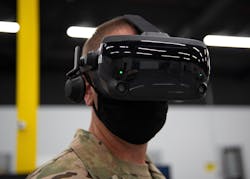By Bill Conrades, Sales Engineering Manager, MBX Systems
It’s hard to believe that immersive technologies have existed for 40 years. VR devices for flight simulation, military training, medical, and auto industry design date back to the early ‘70s, long before many of today’s engineers developing this technology were born.
We can thank the consumer gaming industry for driving the advancements in this technology. With the popularity of games using virtual, augmented and mixed reality, it was only a matter of time before enterprise markets saw better applications for immersive technologies in their own industries.
Just this year, the coronavirus pandemic has added even more urgency to adopting MR because of the constraints around physical contact. Medical personnel use it to treat COVID-19 patients, and the U.S. Army Corps of Engineers was able to increase its site assessments of potential facilities to accommodate people who contracted the virus.
We’re expecting widespread adoption of mixed reality in nearly every industry because the benefits are abundant, including improved employee safety, faster delivery of training programs, increased user retention of information, and reduced risks.
But let’s talk about risks, because risks associated with the technology need to be explored when integrating off-the-shelf, bleeding-edge components inside the hardware device and headsets to operate MR solutions. Software companies need to pay attention to technology options beyond just the headsets.
Multiple factors to explore in MR hardware decisions
The big challenge in MR implementation is adapting consumer-based hardware for enterprise-based use cases. A headset solution used by a gaming enthusiast, for example, won’t survive and meet the ruggedization needs of a military soldier using MR for weapons training in the field. Also, camera resolution is a factor, such as for doctors who require microscopic views of their patients and flight simulation users who must clearly see their instrument panel.
MR hardware often requires customization to get optimal results for different use cases. There are risks around taking an off-the-shelf headset and integrating it with consumer-grade components in a piecemeal fashion. Problems include subpar performance issues, overheating, system noise that interferes with the user experience, and accelerated equipment deterioration from exposure to harsh conditions.
Factors to be considered when developing mixed reality solutions include:
● Connectivity: Does the system have the relevant ports required for headset connectivity?
● Compute and storage: Is the GPU powerful enough to meet the desired frame rate and resolution? Is the storage capacity and performance sufficient for the application?
● Headset components: Based on the MR application, what types of sensors, cameras, microphones, and gaze-tracking capabilities are necessary?
● Cooling: Does the system have inherent cooling mechanisms to reduce noise and optimize performance?
● Ruggedization: Will training occur in a harsh outdoor environment?
● Portability: Is the system easily transportable, both in terms of size and durability?
● Regulatory Compliance: Does the system contain the necessary regulatory certifications for the countries or industries the hardware will be deployed to?
Working with hardware engineers experienced with these technologies delivers a substantial return on a company’s investment. Every use case for MR presents challenges to understand before developing the right solution for the application at the lowest risk.
Bringing stability to bleeding-edge technologies
We talk to customers at all different levels in terms of their experience with mixed reality solutions. For example, some are self-sufficient and well-versed on the headsets, yet they struggle to achieve a stable, repeatable platform. Others know what they need to achieve and we guide them towards a solution, such as a Varjo or Valve Index headset paired with one of our value-engineered mixed reality platforms.
Also often overlooked -- the need for equipment updates and refreshes. MR technology evolves at warp speed, and managing product lifecycles are typically fraught with complexity. Supply chain management and advance purchase services help to extend the life of the MR solution by extending the shelf life of components.
At MBX, that is accomplished with a special interactive toolset called Hatch that helps customers stay on top of component lifecycles and end-of-life considerations. It offers a single point of control and transparency for hardware systems, with direct insight into product lifecycle and engineering changes. The details get pretty granular, such as component country of origin and product regulatory certifications.
Especially with component-rich systems for mixed reality, having access to this kind of toolset simplifies hardware management. It also improves compliance efforts for those organizations in heavily regulated industries.
The next step
Providing the right MR experience — one that is safe, feature-rich, and high performing — means having the right hardware foundation.
The first step is to launch a discovery assessment. Your engineering consultant should conduct a thorough intake session to understand your use case, the tactical and technical ramifications associated with it, as well as any services and regulatory requirements. With that background, they will be able to develop a solution or set of customized options that address your needs and put you on the road to MR excellence.
Bill Conrades is Sales Engineering Manager at MBX Systems, a specialist in purpose-built hardware systems including mixed reality projects. MBX will be showcasing reference hardware for turnkey mixed reality deployments at vIITSEC from Nov. 30-Dec. 4, 2020.

